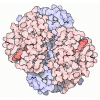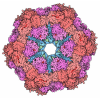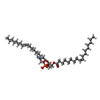[English] 日本語
 Yorodumi
Yorodumi- PDB-8eqs: Structure of SARS-CoV-1 Orf3a in late endosome/lysosome-like envi... -
+ Open data
Open data
- Basic information
Basic information
| Entry | Database: PDB / ID: 8eqs | ||||||
|---|---|---|---|---|---|---|---|
| Title | Structure of SARS-CoV-1 Orf3a in late endosome/lysosome-like environment, MSP1D1 nanodisc | ||||||
 Components Components |
| ||||||
 Keywords Keywords |  VIRAL PROTEIN / VIRAL PROTEIN /  Membrane protein / Membrane protein /  SARS-CoV / SARS-CoV /  SARS-CoV-2 SARS-CoV-2 | ||||||
| Function / homology |  Function and homology information Function and homology information : / Maturation of protein 3a / Defective ABCA1 causes TGD / Scavenging by Class B Receptors / HDL clearance / high-density lipoprotein particle receptor binding / spherical high-density lipoprotein particle / positive regulation of hydrolase activity / negative regulation of response to cytokine stimulus / regulation of intestinal cholesterol absorption ... : / Maturation of protein 3a / Defective ABCA1 causes TGD / Scavenging by Class B Receptors / HDL clearance / high-density lipoprotein particle receptor binding / spherical high-density lipoprotein particle / positive regulation of hydrolase activity / negative regulation of response to cytokine stimulus / regulation of intestinal cholesterol absorption ... : / Maturation of protein 3a / Defective ABCA1 causes TGD / Scavenging by Class B Receptors / HDL clearance / high-density lipoprotein particle receptor binding / spherical high-density lipoprotein particle / positive regulation of hydrolase activity / negative regulation of response to cytokine stimulus / regulation of intestinal cholesterol absorption / protein oxidation / vitamin transport / cholesterol import / high-density lipoprotein particle binding / Microbial modulation of RIPK1-mediated regulated necrosis / : / Maturation of protein 3a / Defective ABCA1 causes TGD / Scavenging by Class B Receptors / HDL clearance / high-density lipoprotein particle receptor binding / spherical high-density lipoprotein particle / positive regulation of hydrolase activity / negative regulation of response to cytokine stimulus / regulation of intestinal cholesterol absorption / protein oxidation / vitamin transport / cholesterol import / high-density lipoprotein particle binding / Microbial modulation of RIPK1-mediated regulated necrosis /  ABC transporters in lipid homeostasis / blood vessel endothelial cell migration / negative regulation of heterotypic cell-cell adhesion / apolipoprotein receptor binding / apolipoprotein A-I receptor binding / negative regulation of cytokine production involved in immune response / negative regulation of cell adhesion molecule production / HDL assembly / peptidyl-methionine modification / negative regulation of very-low-density lipoprotein particle remodeling / phosphatidylcholine biosynthetic process / Translation of Structural Proteins / Virion Assembly and Release / glucocorticoid metabolic process / phosphatidylcholine metabolic process / Chylomicron remodeling / phosphatidylcholine-sterol O-acyltransferase activator activity / positive regulation of phospholipid efflux / ABC transporters in lipid homeostasis / blood vessel endothelial cell migration / negative regulation of heterotypic cell-cell adhesion / apolipoprotein receptor binding / apolipoprotein A-I receptor binding / negative regulation of cytokine production involved in immune response / negative regulation of cell adhesion molecule production / HDL assembly / peptidyl-methionine modification / negative regulation of very-low-density lipoprotein particle remodeling / phosphatidylcholine biosynthetic process / Translation of Structural Proteins / Virion Assembly and Release / glucocorticoid metabolic process / phosphatidylcholine metabolic process / Chylomicron remodeling / phosphatidylcholine-sterol O-acyltransferase activator activity / positive regulation of phospholipid efflux /  lipid storage / lipid storage /  Chylomicron assembly / positive regulation of cholesterol metabolic process / phospholipid homeostasis / high-density lipoprotein particle clearance / high-density lipoprotein particle remodeling / phospholipid efflux / cholesterol transfer activity / Chylomicron assembly / positive regulation of cholesterol metabolic process / phospholipid homeostasis / high-density lipoprotein particle clearance / high-density lipoprotein particle remodeling / phospholipid efflux / cholesterol transfer activity /  reverse cholesterol transport / reverse cholesterol transport /  chemorepellent activity / high-density lipoprotein particle assembly / very-low-density lipoprotein particle / cholesterol transport / positive regulation of CoA-transferase activity / lipoprotein biosynthetic process / high-density lipoprotein particle / endothelial cell proliferation / chemorepellent activity / high-density lipoprotein particle assembly / very-low-density lipoprotein particle / cholesterol transport / positive regulation of CoA-transferase activity / lipoprotein biosynthetic process / high-density lipoprotein particle / endothelial cell proliferation /  regulation of Cdc42 protein signal transduction / triglyceride homeostasis / inorganic cation transmembrane transport / HDL remodeling / negative regulation of interleukin-1 beta production / Scavenging by Class A Receptors / cholesterol efflux / regulation of Cdc42 protein signal transduction / triglyceride homeostasis / inorganic cation transmembrane transport / HDL remodeling / negative regulation of interleukin-1 beta production / Scavenging by Class A Receptors / cholesterol efflux /  cholesterol binding / cholesterol binding /  voltage-gated calcium channel complex / negative chemotaxis / positive regulation of Rho protein signal transduction / adrenal gland development / host cell Golgi membrane / cholesterol biosynthetic process / endocytic vesicle / negative regulation of tumor necrosis factor-mediated signaling pathway / positive regulation of cholesterol efflux / Scavenging of heme from plasma / voltage-gated calcium channel complex / negative chemotaxis / positive regulation of Rho protein signal transduction / adrenal gland development / host cell Golgi membrane / cholesterol biosynthetic process / endocytic vesicle / negative regulation of tumor necrosis factor-mediated signaling pathway / positive regulation of cholesterol efflux / Scavenging of heme from plasma /  voltage-gated potassium channel complex / positive regulation of phagocytosis / Attachment and Entry / positive regulation of substrate adhesion-dependent cell spreading / Retinoid metabolism and transport / positive regulation of stress fiber assembly / endocytic vesicle lumen / voltage-gated potassium channel complex / positive regulation of phagocytosis / Attachment and Entry / positive regulation of substrate adhesion-dependent cell spreading / Retinoid metabolism and transport / positive regulation of stress fiber assembly / endocytic vesicle lumen /  heat shock protein binding / cholesterol metabolic process / cholesterol homeostasis / integrin-mediated signaling pathway / heat shock protein binding / cholesterol metabolic process / cholesterol homeostasis / integrin-mediated signaling pathway /  Post-translational protein phosphorylation / Post-translational protein phosphorylation /  regulation of protein phosphorylation / regulation of protein phosphorylation /  : / Heme signaling / : / Heme signaling /  phospholipid binding / PPARA activates gene expression / negative regulation of inflammatory response / Regulation of Insulin-like Growth Factor (IGF) transport and uptake by Insulin-like Growth Factor Binding Proteins (IGFBPs) / phospholipid binding / PPARA activates gene expression / negative regulation of inflammatory response / Regulation of Insulin-like Growth Factor (IGF) transport and uptake by Insulin-like Growth Factor Binding Proteins (IGFBPs) /  extracellular vesicle / Platelet degranulation / protein complex oligomerization / monoatomic ion channel activity / extracellular vesicle / Platelet degranulation / protein complex oligomerization / monoatomic ion channel activity /  amyloid-beta binding / cytoplasmic vesicle / secretory granule lumen / collagen-containing extracellular matrix / blood microparticle / protein stabilization / amyloid-beta binding / cytoplasmic vesicle / secretory granule lumen / collagen-containing extracellular matrix / blood microparticle / protein stabilization /  early endosome / symbiont-mediated suppression of host type I interferon-mediated signaling pathway / G protein-coupled receptor signaling pathway early endosome / symbiont-mediated suppression of host type I interferon-mediated signaling pathway / G protein-coupled receptor signaling pathwaySimilarity search - Function | ||||||
| Biological species |   Severe acute respiratory syndrome coronavirus Severe acute respiratory syndrome coronavirus  Homo sapiens (human) Homo sapiens (human) | ||||||
| Method |  ELECTRON MICROSCOPY / ELECTRON MICROSCOPY /  single particle reconstruction / single particle reconstruction /  cryo EM / Resolution: 3.1 Å cryo EM / Resolution: 3.1 Å | ||||||
 Authors Authors | Miller, A.N. / Houlihan, P.R. / Matamala, E. / Cabezas-Bratesco, D. / Lee, G.Y. / Cristofori-Armstrong, B. / Dilan, T.L. / Sanchez-Martinez, S. / Matthies, D. / Yan, R. ...Miller, A.N. / Houlihan, P.R. / Matamala, E. / Cabezas-Bratesco, D. / Lee, G.Y. / Cristofori-Armstrong, B. / Dilan, T.L. / Sanchez-Martinez, S. / Matthies, D. / Yan, R. / Yu, Z. / Ren, D. / Brauchi, S.E. / Clapham, D.E. | ||||||
| Funding support |  United States, 1items United States, 1items
| ||||||
 Citation Citation |  Journal: Elife / Year: 2023 Journal: Elife / Year: 2023Title: The SARS-CoV-2 accessory protein Orf3a is not an ion channel, but does interact with trafficking proteins. Authors: Alexandria N Miller / Patrick R Houlihan / Ella Matamala / Deny Cabezas-Bratesco / Gi Young Lee / Ben Cristofori-Armstrong / Tanya L Dilan / Silvia Sanchez-Martinez / Doreen Matthies / Rui ...Authors: Alexandria N Miller / Patrick R Houlihan / Ella Matamala / Deny Cabezas-Bratesco / Gi Young Lee / Ben Cristofori-Armstrong / Tanya L Dilan / Silvia Sanchez-Martinez / Doreen Matthies / Rui Yan / Zhiheng Yu / Dejian Ren / Sebastian E Brauchi / David E Clapham /   Abstract: The severe acute respiratory syndrome associated coronavirus 2 (SARS-CoV-2) and SARS-CoV-1 accessory protein Orf3a colocalizes with markers of the plasma membrane, endocytic pathway, and Golgi ...The severe acute respiratory syndrome associated coronavirus 2 (SARS-CoV-2) and SARS-CoV-1 accessory protein Orf3a colocalizes with markers of the plasma membrane, endocytic pathway, and Golgi apparatus. Some reports have led to annotation of both Orf3a proteins as viroporins. Here, we show that neither SARS-CoV-2 nor SARS-CoV-1 Orf3a form functional ion conducting pores and that the conductances measured are common contaminants in overexpression and with high levels of protein in reconstitution studies. Cryo-EM structures of both SARS-CoV-2 and SARS-CoV-1 Orf3a display a narrow constriction and the presence of a positively charged aqueous vestibule, which would not favor cation permeation. We observe enrichment of the late endosomal marker Rab7 upon SARS-CoV-2 Orf3a overexpression, and co-immunoprecipitation with VPS39. Interestingly, SARS-CoV-1 Orf3a does not cause the same cellular phenotype as SARS-CoV-2 Orf3a and does not interact with VPS39. To explain this difference, we find that a divergent, unstructured loop of SARS-CoV-2 Orf3a facilitates its binding with VPS39, a HOPS complex tethering protein involved in late endosome and autophagosome fusion with lysosomes. We suggest that the added loop enhances SARS-CoV-2 Orf3a's ability to co-opt host cellular trafficking mechanisms for viral exit or host immune evasion. #1: Journal: bioRxiv / Year: 2022 Title: The SARS-CoV-2 accessory protein Orf3a is not an ion channel, but does interact with trafficking proteins. Authors: Alexandria N Miller / Patrick R Houlihan / Ella Matamala / Deny Cabezas-Bratesco / Gi Young Lee / Ben Cristofori-Armstrong / Tanya L Dilan / Silvia Sanchez-Martinez / Doreen Matthies / Rui ...Authors: Alexandria N Miller / Patrick R Houlihan / Ella Matamala / Deny Cabezas-Bratesco / Gi Young Lee / Ben Cristofori-Armstrong / Tanya L Dilan / Silvia Sanchez-Martinez / Doreen Matthies / Rui Yan / Zhiheng Yu / Dejian Ren / Sebastian E Brauchi / David E Clapham Abstract: The severe acute respiratory syndrome associated coronavirus 2 (SARS-CoV-2) and SARS-CoV-1 accessory protein Orf3a colocalizes with markers of the plasma membrane, endocytic pathway, and Golgi ...The severe acute respiratory syndrome associated coronavirus 2 (SARS-CoV-2) and SARS-CoV-1 accessory protein Orf3a colocalizes with markers of the plasma membrane, endocytic pathway, and Golgi apparatus. Some reports have led to annotation of both Orf3a proteins as a viroporin. Here we show that neither SARS-CoV-2 nor SARS-CoV-1 form functional ion conducting pores and that the conductances measured are common contaminants in overexpression and with high levels of protein in reconstitution studies. Cryo-EM structures of both SARS-CoV-2 and SARS-CoV-1 Orf3a display a narrow constriction and the presence of a basic aqueous vestibule, which would not favor cation permeation. We observe enrichment of the late endosomal marker Rab7 upon SARS-CoV-2 Orf3a overexpression, and co-immunoprecipitation with VPS39. Interestingly, SARS-CoV-1 Orf3a does not cause the same cellular phenotype as SARS-CoV-2 Orf3a and does not interact with VPS39. To explain this difference, we find that a divergent, unstructured loop of SARS-CoV-2 Orf3a facilitates its binding with VPS39, a HOPS complex tethering protein involved in late endosome and autophagosome fusion with lysosomes. We suggest that the added loop enhances SARS-CoV-2 Orf3a ability to co-opt host cellular trafficking mechanisms for viral exit or host immune evasion. | ||||||
| History |
|
- Structure visualization
Structure visualization
| Structure viewer | Molecule:  Molmil Molmil Jmol/JSmol Jmol/JSmol |
|---|
- Downloads & links
Downloads & links
- Download
Download
| PDBx/mmCIF format |  8eqs.cif.gz 8eqs.cif.gz | 97.5 KB | Display |  PDBx/mmCIF format PDBx/mmCIF format |
|---|---|---|---|---|
| PDB format |  pdb8eqs.ent.gz pdb8eqs.ent.gz | 72.3 KB | Display |  PDB format PDB format |
| PDBx/mmJSON format |  8eqs.json.gz 8eqs.json.gz | Tree view |  PDBx/mmJSON format PDBx/mmJSON format | |
| Others |  Other downloads Other downloads |
-Validation report
| Arichive directory |  https://data.pdbj.org/pub/pdb/validation_reports/eq/8eqs https://data.pdbj.org/pub/pdb/validation_reports/eq/8eqs ftp://data.pdbj.org/pub/pdb/validation_reports/eq/8eqs ftp://data.pdbj.org/pub/pdb/validation_reports/eq/8eqs | HTTPS FTP |
|---|
-Related structure data
| Related structure data |  28544MC  8eqjC  8eqtC  8equC M: map data used to model this data C: citing same article ( |
|---|---|
| Similar structure data | Similarity search - Function & homology  F&H Search F&H Search |
- Links
Links
- Assembly
Assembly
| Deposited unit | 
|
|---|---|
| 1 |
|
- Components
Components
| #1: Protein | Mass: 36268.219 Da / Num. of mol.: 2 Source method: isolated from a genetically manipulated source Source: (gene. exp.)   Severe acute respiratory syndrome coronavirus Severe acute respiratory syndrome coronavirusGene: 3a / Production host:   Homo sapiens (human) / References: UniProt: P59632 Homo sapiens (human) / References: UniProt: P59632#2: Protein |  Apolipoprotein AI / Apo-AI / ApoA-I / Apolipoprotein A1 / MSP1D1 scaffold protein Apolipoprotein AI / Apo-AI / ApoA-I / Apolipoprotein A1 / MSP1D1 scaffold proteinMass: 24704.729 Da / Num. of mol.: 2 Source method: isolated from a genetically manipulated source Source: (gene. exp.)   Homo sapiens (human) / Gene: APOA1 / Production host: Homo sapiens (human) / Gene: APOA1 / Production host:   Escherichia coli (E. coli) / References: UniProt: P02647 Escherichia coli (E. coli) / References: UniProt: P02647#3: Chemical |  Discrete optimized protein energy Discrete optimized protein energyHas ligand of interest | N | |
|---|
-Experimental details
-Experiment
| Experiment | Method:  ELECTRON MICROSCOPY ELECTRON MICROSCOPY |
|---|---|
| EM experiment | Aggregation state: PARTICLE / 3D reconstruction method:  single particle reconstruction single particle reconstruction |
- Sample preparation
Sample preparation
| Component | Name: Structure of SARS-CoV-1 Orf3a in late endosome/lysosome-like environment, MSP1D1 nanodisc Type: COMPLEX / Entity ID: #1-#2 / Source: RECOMBINANT |
|---|---|
| Molecular weight | Experimental value: NO |
| Source (natural) | Organism:   Homo sapiens (human) Homo sapiens (human) |
| Source (recombinant) | Organism:   Escherichia coli (E. coli) Escherichia coli (E. coli) |
| Buffer solution | pH: 7.5 |
| Specimen | Embedding applied: NO / Shadowing applied: NO / Staining applied : NO / Vitrification applied : NO / Vitrification applied : YES : YES |
Vitrification | Cryogen name: ETHANE |
- Electron microscopy imaging
Electron microscopy imaging
| Experimental equipment |  Model: Titan Krios / Image courtesy: FEI Company |
|---|---|
| Microscopy | Model: FEI TITAN KRIOS |
| Electron gun | Electron source : :  FIELD EMISSION GUN / Accelerating voltage: 300 kV / Illumination mode: FLOOD BEAM FIELD EMISSION GUN / Accelerating voltage: 300 kV / Illumination mode: FLOOD BEAM |
| Electron lens | Mode: BRIGHT FIELD Bright-field microscopy / Nominal defocus max: 2000 nm / Nominal defocus min: 800 nm Bright-field microscopy / Nominal defocus max: 2000 nm / Nominal defocus min: 800 nm |
| Image recording | Electron dose: 50 e/Å2 / Film or detector model: GATAN K3 (6k x 4k) / Num. of grids imaged: 1 / Num. of real images: 13970 |
| EM imaging optics | Energyfilter name : GIF Bioquantum : GIF Bioquantum |
- Processing
Processing
| EM software |
| ||||||||||||||||||||||||
|---|---|---|---|---|---|---|---|---|---|---|---|---|---|---|---|---|---|---|---|---|---|---|---|---|---|
CTF correction | Type: NONE | ||||||||||||||||||||||||
| Symmetry | Point symmetry : C2 (2 fold cyclic : C2 (2 fold cyclic ) ) | ||||||||||||||||||||||||
3D reconstruction | Resolution: 3.1 Å / Resolution method: FSC 0.143 CUT-OFF / Num. of particles: 162607 / Num. of class averages: 1 / Symmetry type: POINT | ||||||||||||||||||||||||
| Atomic model building | Protocol: AB INITIO MODEL |
 Movie
Movie Controller
Controller





 PDBj
PDBj

















